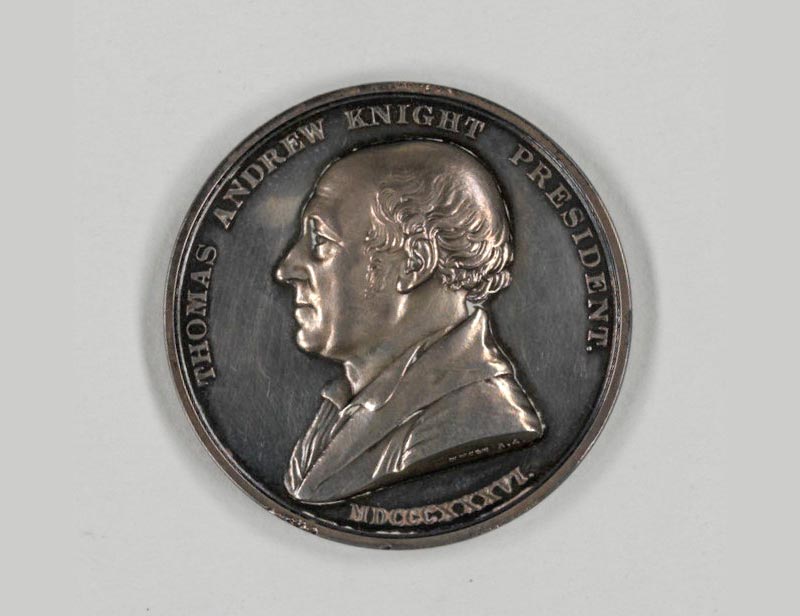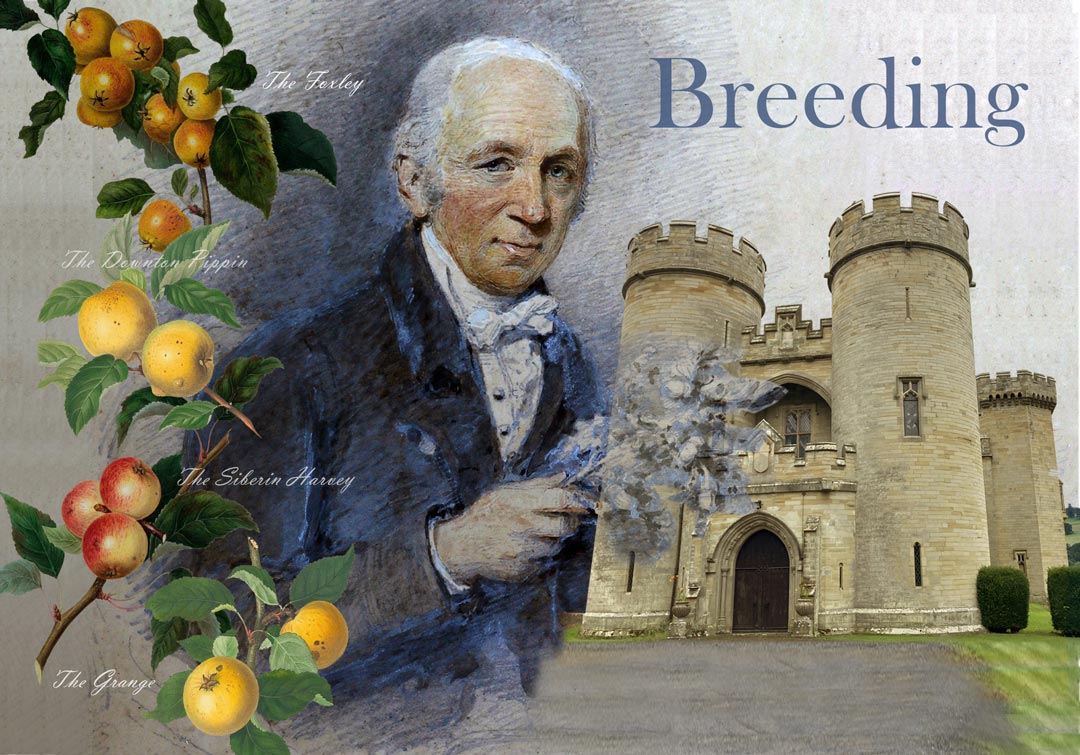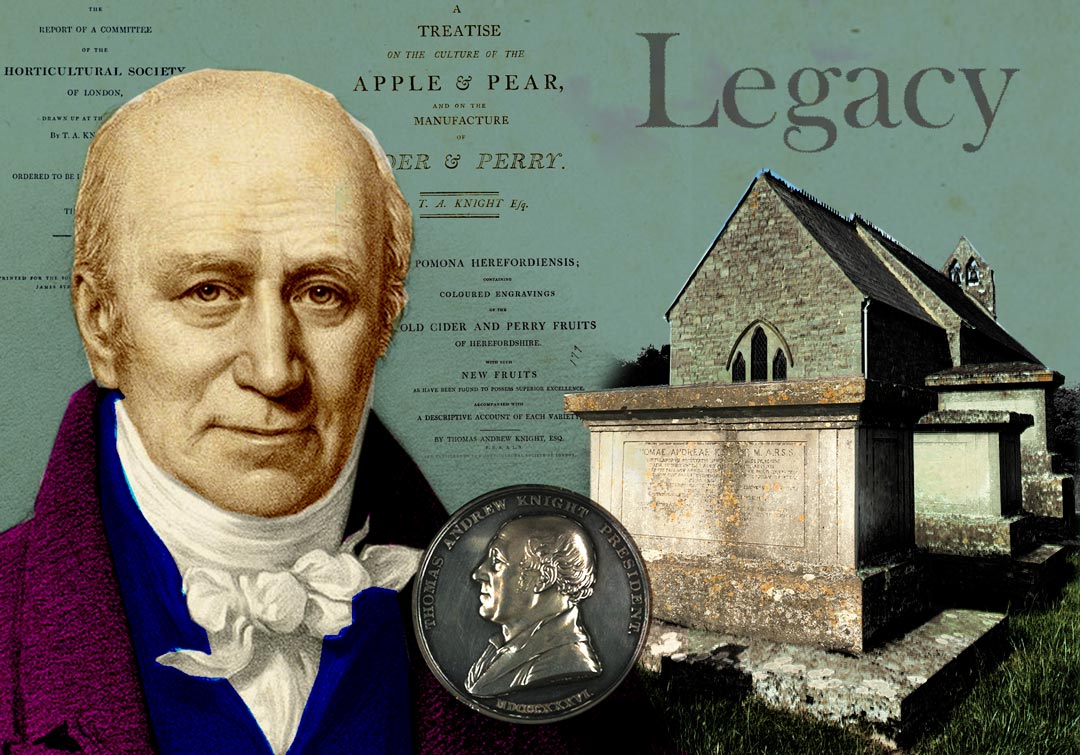Gentleman of Genius
Thomas Andrew Knight, Herefordshire’s vanguard of pomology
Thomas Andrew Knight (1759-1838) was born into a wealthy Herefordshire family which had made its money from the iron industry in the north of Herefordshire and neighbouring counties. He lived the later part of his life on the family Estate of Downton Castle in Herefordshire, which was passed to him by his brother. On 1 January 1811 Knight was elected second President of what was to become the Royal Horticultural Society in London, having a few years earlier been instrumental in establishing the purpose of the Society as practical scientific endeavour:
“there scarce exists a single species of esculent plant or fruit, which (relative to the use of man) has yet attained its utmost state of perfection; nor any branch of practical Horticulture which is not still susceptible of essential improvement”
Thomas Andrew Knight
From an early age Knight was fascinated by nature. He came to understand the practical potential of plant hybridisation to enhance fruit quality and productivity, by conscious selection of natural variations. During his lifetime he bred many new varieties of cider and dessert apple using hand pollination. He describes his methods of pollination in detail in his book Pomona Herefordiensis. The results, often named after places in Herefordshire, include the apples The Grange, Downton Pippin, Red Ingestrie, Yellow Ingestrie, Breinton Seedling, Bringewood Pippin, Wormsley Pippin, Yellow Siberian, Foxley Apple, Siberian Harvey, Spring Grove Codling, and Herefordshire Gilliflower.
Knight appears to have been one of the first to record the use of controlled pollination, producing new varieties of apple by crossing existing cultivars and selecting the best from resulting progeny. His successes were the result of painstaking work. For example, he recounts that the Siberian Harvey, which produces a sweet juice of high specific gravity that will likely produce a rich cider, was one of just three or four apples from three hundred crosses that showed any merit.
“seedling plants…, of every cultivated species, sport in endless variety. By selection from these therefore we can only hope for success in our pursuit of new and improved varieties of each species of plant or fruit…”
Thomas Andrew Knight
His plant breeding extended well beyond apples to pears, cherries, strawberries, plums, peaches, nectarines, redcurrants, potatoes, cabbages, and peas.
Over one hundred of Knight’s reports were published by the Horticultural Society and Royal Society, recording the results of his extensive and diverse research. He contributed papers to all the Horticultural Society’s ‘Transactions’ from their first publication in 1807 until his death. This linked his independent practical experimentation at his home in rural Herefordshire with the intelligentsia in London, which he visited annually. He was a Fellow of the Royal Society and developed close and productive relationships with the leading botanist Sir Joseph Banks (1743-1820) and the scientist Sir Humphry Davy (1778-1829), its successive Presidents.
His papers were on subjects as diverse as tree sap, manure, the effect of gravity on plants, climate change, fossils, and greenhouses. He designed and built a curvilinear greenhouse at Downton Castle to optimise the angle of incidence of the sun through the glass for ideal growing conditions. He invented a turnip seed drill and a razor sharpener. His observations on the specific gravity of apple juice were fundamental to the development of the cider industry.
“His mind was original, clear and essentially practical”
Dr Henry Bull in Herefordshire Pomona
In all of this, his overriding interest was to improve the physical welfare of society.
His two published books focused on the apple: In ‘A Treatise on the Culture of the Apple and Pear, and on the Manufacture of Cider and Perry’, first published in 1797, he gave practical guidance on orchard management and making cider. Later, given his concerns about the declining quality of cider fruit, and harvesting the fruits of his own apple breeding programme, he recorded old and new cider apples and perry pears in his ‘Pomona Herefordiensis’, promoting four of his own new varieties.
The Pomona Herefordiensis was initially published in instalments to subscribers by the Agricultural Society of Herefordshire and subsequently as a complete volume in 1811. It was a high-quality production, illustrated with hand-coloured engravings from paintings mainly by Elizabeth Matthews from Hereford, reproduced by one of the best botanical engravers of the time.
Home life was important to Knight, and his daughter Frances (1794-1881) was a particular favourite. From an early age she spent much time with her father in the gardens.
“From the time I could toddle after him, he made me his companion and the time that ought to have been spent in the schoolroom was spent with him in his garden”
Frances Stackhouse Acton (nee Knight)
Despite having been described by her father in the foreword of Pomona Herefordiensis, perhaps through humility, as “a very young and inferior artist of my own family” Frances was an accomplished painter – Knight goes on to describe her drawings as “most perfectly correct”. She is unique as the only person to paint apples for both the Pomona Herefordiensis (Stead’s Kernal, Old Pearmain, and Friar) and the Herefordshire Pomona (Eggleton Styre) sixty years later.
Knight’s experimentation was prolific and his conclusions penetrating. He would probably have thought of himself as a philosophical gentleman, but his scientific ideas were vastly influential although many of his pioneering ideas required elaboration and more detailed study by others.
“The great services he rendered to his country are not however to be measured so much by the actual work he did himself, as by the work he originated for others to follow up”
Dr Henry Bull in Herefordshire Pomona
Knight was a source for both John Lindley’s scientific theory of horticulture and Davy’s chemistry of agriculture. He essentially outlined the process of evolution by natural selection fifty years before Darwin’s ‘On the Origin of Species’, and his breeding experiments are acknowledged in the first chapter of that work. He had thought about the influence of male and female parents on their offspring and what he called “instinctive hereditary propensity”. Furthermore, although his primary objective was to obtain new and improved varieties of apple, in 1787 he started breeding peas, being an annual plant where results could be more quickly observed than apples. Knight crossed peas of different colours and noted that when the pollen of a purple-flowered plant was introduced into the emasculated blossom of a white coloured one all the resulting peas subsequently gave rise to plants with purple flowers, also observing for the first time how characteristics like height and blossom changed through the generations. His results were published in a Royal Society paper in 1799, establishing traits which were more fully described and statistically analysed into the principles of genetics by Gregor Mendel over sixty years later.
Corresponding with horticulturalists around the world, and sending plants to them, was rewarded with honorary memberships and medals from agricultural and horticultural societies across Europe and America, and in Russia and Australia. He exchanged seeds with a correspondent in Persia and sent large numbers of scions of his new fruit trees to the Massachusetts Agricultural Society, helping to develop the North American apple industry,
Knight had an enquiring mind, a keen sense of observation, and an ability to frame his investigations precisely. Shy and introverted, he worked largely independently in rural Herefordshire for most of his life, but his findings were profound.
“the celebrated Philosopher & horticulturalist to whom we owe so many important discoveries on the physiology of plants”
Sir Humphry Davy
His influence on the study of plants, especially apples and the new field of pomology, was far reaching.
Sources:
- Stackhouse Acton (1873) Memoirs, with permission from Bedfordshire Archives
- Hogg and Bull (1876-1885) The Herefordshire Pomona
- Knight (1799) An Account of some Experiments on the Fecundation of Vegetables in Philosophical Transactions of the Royal Society
- Knight (1805) The Report of a Committee of the Horticultural Society of London
- Knight (1811) Pomona Herefordiensis
- Knight (1841) A selection from the physiological and horticultural papers published in the Transactions of the Royal and Horticultural Societies by the late Thomas Andrew Knight Esq (edited Bentham and Lindley)
- Rolfe-Smith (2020) The Knight Family of Downton Castle
Thanks to:
- Dr Andrew Evans who helped author this Apple Story, which he dedicates to the memory of Gillian Bulmer “I think it was a measure of her admiration for Thomas Andrew Knight and her understanding of the importance of his research work, that she often remarked, both to myself and to others, that without him there would have been no Bulmers cider”.
Four faces of Knight by Chris Hellowell
An Apples & People Commission to illustrate the story of Thomas Andrew Knight
Chris Hellowell’s brief was to provide four illustrations to accompany the story of Thomas Andrew Knight and show the importance of his studies of the apple. Working closely with the text and using Knight family portraits and works by Knight and his daughter Frances, Hellowell has created a stunning series of digital collages.
Chris says of the commission “It has been fascinating and highly rewarding to work with such beautiful original imagery and text. I gained a deep insight into the period and scientific environment in which Knight worked. I hope this has been communicated to some extent in the designs. As an artist I feel a need to connect with other people and sadly the pandemic has isolated so many of us. This exciting commission was a shot in the arm as it gave me a sense of purpose.”
Thanks to Francis Acton of Acton Scott; the owner of Downton Castle; Philippa Wiggin of Downton Hall; the library staff at RHS Lindley Library; Rhys Griffiths, Senior Archivist at Herefordshire Archives and Records Centre; and Hereford Cider Museum Trust for providing access to their Collections, and to Tom Wall for sharing image research.
Source Images:
Breeding
- Thomas Andrew Knight by Henry Edridge 1820, courtesy of Downton Hall. Photography © Gareth Thomas.
- Varieties bred by Knight depicted in his Pomona Herefordiensis 1811
- Downton Castle, Herefordshire.
Research
- Thomas Andrew Knight by unknown artist, courtesy of © Hereford Cider Museum Trust.
- Extracts from Knight On the comparative influence of male and female parents on their offspring (read before the Royal Society 1809) and Account of some experiments on the ascent of sap (read before the Royal Society 1801).
- Extracts from Knight’s breeding notebook held by Herefordshire Archive and Resources Centre Photography © Herefordshire Council.
- Knight’s curvilinear greenhouse built at Downton Castle in 1822 Photography © James Bisset.
Frances
- Frances Knight by Henry Edridge 1820. Courtesy of Acton Scott Hall. Photography © Christopher Preece www.infinityunlimited.co.uk
- Frances Stackhouse Acton by A.D. La Touche 1868. Courtesy of Acton Scott Hall. Photography © Christopher Preece www.infinityunlimited.co.uk
- Apples painted by Frances in her father’s Pomona Herefordiensis 1811.
- Apple painted by Frances in the Herefordshire Pomona 1885.
Legacy
- Printed Lithographic portrait of Thomas Andrew Knight (Richard James Lane after Solomon Cole). Frontispiece of A selection from the physiological and horticultural papers published in the Transactions of the Royal and Horticultural Societies, by Thomas Andrew Knight, published in London in 1841 (c) RHS Lindley Collections
- Thomas Andrew Knight’s grave at the Church of St Mary, Wormsley, Herefordshire
- Silver Knightian Medal depicting a portrait of Thomas Andrew Knight 1836 (c) RHS Lindley Collections
- Frontispieces of Knight’s keynote papers A Treatise on the Culture of the Apple and Pear Second edition (1801), The Report of a Committee of the Horticultural Society of London (1805) and Pomona Herefordiensis (1811)









 JJ Lankes
JJ Lankes Idun and Brage, 1846, oil on canvas by Nils Jakob Blommér, Malmö Art Museum, Sweden
Idun and Brage, 1846, oil on canvas by Nils Jakob Blommér, Malmö Art Museum, Sweden